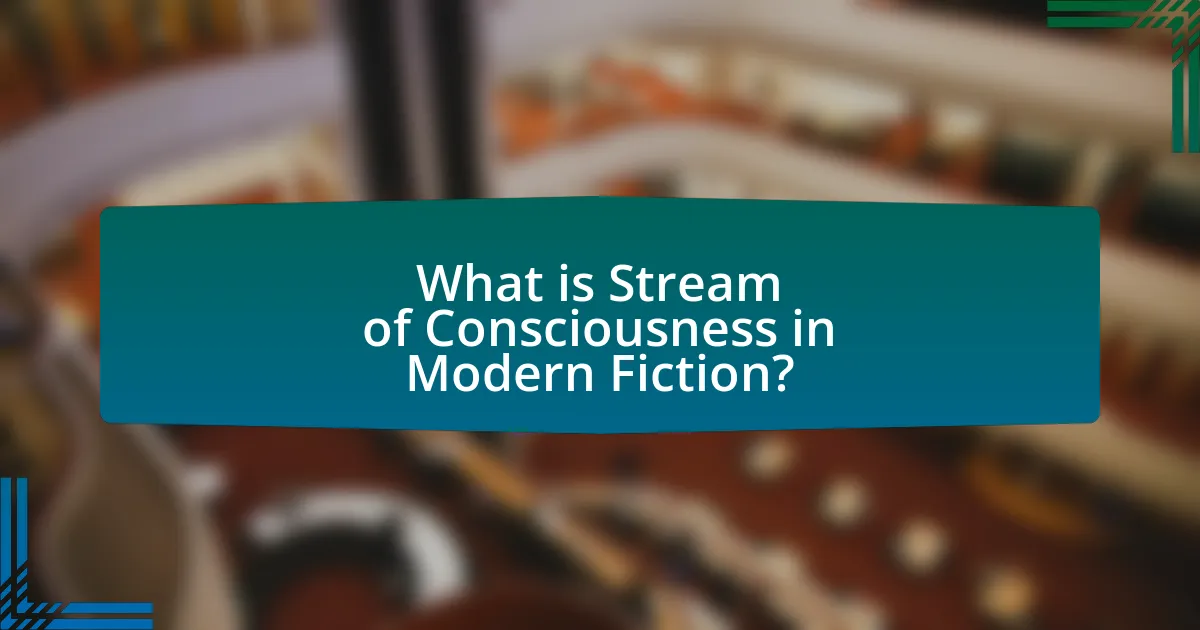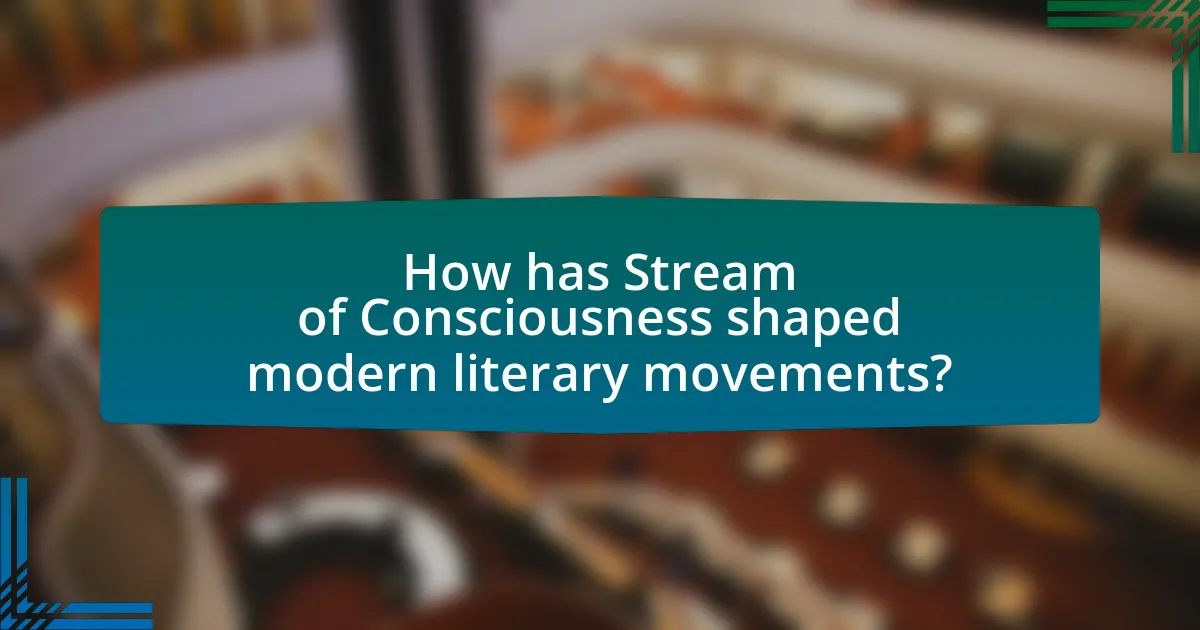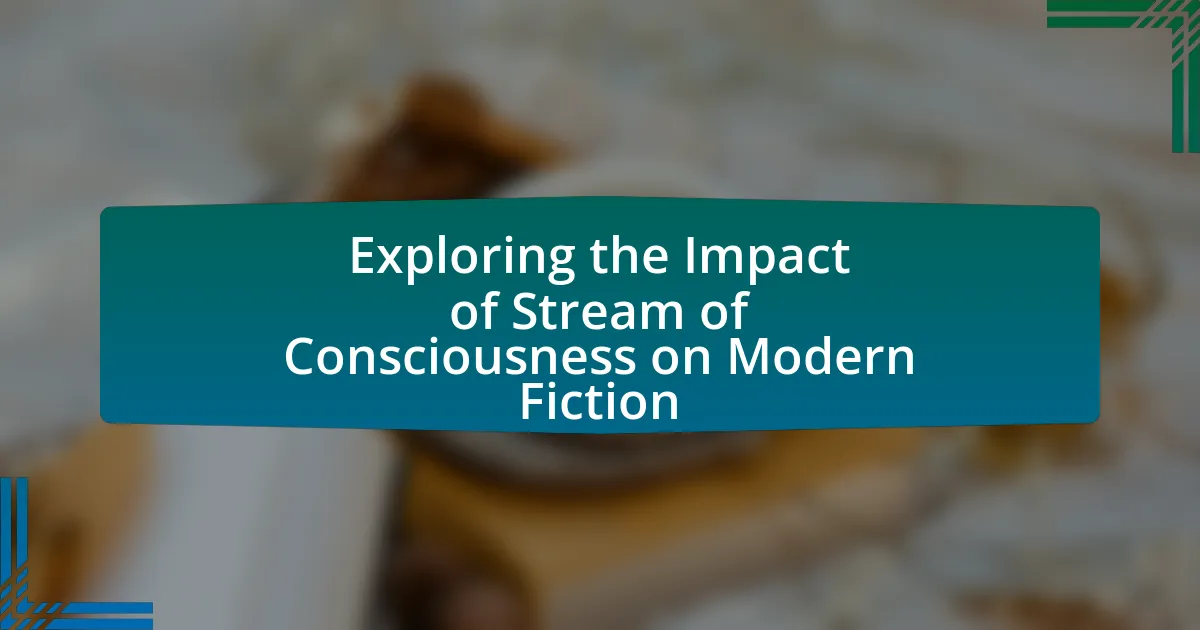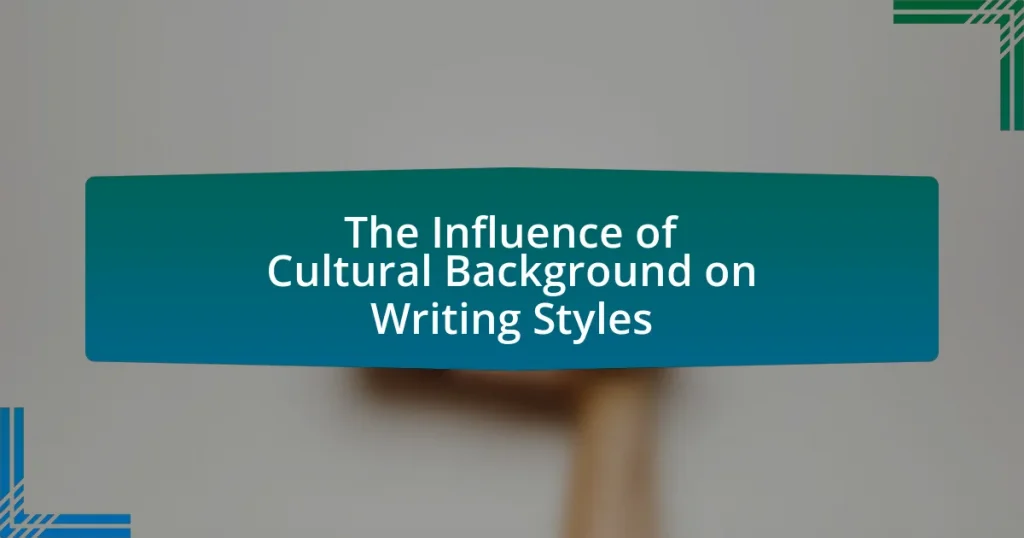Stream of consciousness is a narrative technique in modern fiction that captures the continuous flow of thoughts and feelings within a character’s mind, often disregarding traditional narrative structures. This article explores the emergence of this technique in the early 20th century, influenced by psychological theories from figures like Sigmund Freud and William James. It examines key characteristics, historical influences, and notable examples from authors such as James Joyce and Virginia Woolf, highlighting how this style enhances character development and reader engagement. Additionally, the article discusses the significance of stream of consciousness in shaping modern literary movements and its implications for contemporary authors.

What is Stream of Consciousness in Modern Fiction?
Stream of consciousness in modern fiction is a narrative technique that captures the flow of thoughts and feelings in a character’s mind. This method allows authors to present a character’s internal monologue, often disregarding traditional narrative structures and punctuation. Notable examples include James Joyce’s “Ulysses” and Virginia Woolf’s “Mrs. Dalloway,” where the technique immerses readers in the characters’ subjective experiences. The effectiveness of this approach is evidenced by its ability to convey complex emotional states and the intricacies of human consciousness, thereby influencing the development of modernist literature.
How did Stream of Consciousness emerge as a literary technique?
Stream of Consciousness emerged as a literary technique in the early 20th century, primarily influenced by the psychological theories of Sigmund Freud and the desire to depict the inner thoughts and feelings of characters. This technique allows authors to present a character’s thoughts in a continuous flow, often disregarding conventional narrative structures. Notable early practitioners include James Joyce, whose work “Ulysses” (1922) exemplifies this style, and Virginia Woolf, who utilized it in novels like “Mrs. Dalloway” (1925). The technique reflects a shift towards exploring subjective experience and consciousness, marking a significant evolution in modern fiction.
What are the historical influences on Stream of Consciousness?
Stream of Consciousness is historically influenced by philosophical ideas, particularly those of William James, who introduced the concept of the “stream of thought” in his work “The Principles of Psychology” (1890). This psychological framework emphasized the fluidity of human consciousness and the interconnectedness of thoughts, which directly inspired literary techniques. Additionally, modernist writers such as Virginia Woolf and James Joyce adopted and adapted these ideas, employing narrative styles that reflect the inner workings of the mind, as seen in Woolf’s “Mrs. Dalloway” and Joyce’s “Ulysses.” These works exemplify how the stream of consciousness technique captures the complexity of human experience, influenced by both psychological theories and the modernist movement’s break from traditional narrative forms.
How does Stream of Consciousness differ from traditional narrative styles?
Stream of Consciousness differs from traditional narrative styles by prioritizing the internal thoughts and feelings of characters over structured plot development. This technique allows for a more fluid and fragmented representation of consciousness, often mimicking the natural flow of thoughts, as seen in works by authors like Virginia Woolf and James Joyce. Traditional narratives typically follow a linear progression with clear exposition, rising action, climax, and resolution, whereas Stream of Consciousness often eschews these conventions, resulting in a more immersive and subjective reading experience. This approach reflects the complexities of human thought and perception, challenging readers to engage with the text on a deeper emotional and psychological level.
What are the key characteristics of Stream of Consciousness?
Stream of Consciousness is a narrative technique that captures the flow of thoughts and feelings in a character’s mind. Key characteristics include a lack of conventional structure, as it often eschews traditional grammar and punctuation to reflect the chaotic nature of thought. This technique frequently employs free association, allowing ideas to emerge in a nonlinear fashion, mirroring the way human consciousness operates. Additionally, it often features interior monologues, where characters express their inner thoughts directly, providing deep psychological insight. Notable examples of this technique can be found in the works of authors such as Virginia Woolf and James Joyce, who utilized it to explore complex emotional landscapes and the intricacies of human experience.
How does the technique reflect the inner thoughts of characters?
The stream of consciousness technique reflects the inner thoughts of characters by presenting their thoughts in a continuous flow, mimicking natural thought processes. This technique allows readers to experience the characters’ emotions, memories, and perceptions in real-time, creating a deeper psychological insight. For example, in Virginia Woolf’s “Mrs. Dalloway,” the narrative shifts seamlessly between characters’ thoughts, revealing their inner conflicts and desires, which enhances the reader’s understanding of their motivations and emotional states. This method effectively captures the complexity of human consciousness, illustrating how thoughts are often fragmented and non-linear, thereby providing a more authentic representation of character psychology.
What role does fragmentation play in Stream of Consciousness narratives?
Fragmentation in Stream of Consciousness narratives serves to reflect the chaotic and nonlinear nature of human thought. This technique allows authors to depict the inner workings of characters’ minds, capturing fleeting thoughts, memories, and sensory experiences in a way that mirrors real cognitive processes. For instance, Virginia Woolf’s “To the Lighthouse” employs fragmentation to illustrate the characters’ shifting perceptions and emotional states, emphasizing the complexity of their inner lives. This narrative style enhances the reader’s engagement by immersing them in the characters’ subjective experiences, thereby deepening the exploration of themes such as time, identity, and consciousness.
Why is Stream of Consciousness significant in modern fiction?
Stream of Consciousness is significant in modern fiction because it allows authors to depict the inner thoughts and feelings of characters in a more authentic and nuanced manner. This narrative technique breaks away from traditional linear storytelling, enabling a deeper exploration of consciousness and subjective experience. Notable examples include James Joyce’s “Ulysses” and Virginia Woolf’s “Mrs. Dalloway,” where the technique captures the complexity of human thought processes, reflecting the fragmented nature of reality. The use of Stream of Consciousness has influenced contemporary writers, encouraging them to experiment with narrative form and delve into psychological depth, thereby reshaping the landscape of modern literature.
How has it influenced contemporary authors and their works?
Stream of consciousness has significantly influenced contemporary authors and their works by enabling them to explore the inner thoughts and emotions of characters in a more fluid and nuanced manner. This narrative technique allows writers like Virginia Woolf and James Joyce to delve into the complexities of human consciousness, which contemporary authors such as David Foster Wallace and Zadie Smith have adopted to create rich, multi-layered narratives. For instance, Wallace’s “Infinite Jest” employs stream of consciousness to reflect the chaotic nature of modern life, while Smith’s “White Teeth” uses it to capture the diverse experiences of her characters. This technique has reshaped narrative structures, encouraging authors to experiment with form and style, ultimately leading to a more immersive reading experience.
What themes are commonly explored through this narrative style?
The themes commonly explored through the stream of consciousness narrative style include the complexity of human thought, the fluidity of time, and the nature of identity. This narrative technique allows authors to depict the inner workings of characters’ minds, showcasing their thoughts and emotions in a non-linear fashion. For instance, Virginia Woolf’s “Mrs. Dalloway” illustrates the interconnectedness of past and present, emphasizing how memories shape identity. Similarly, James Joyce’s “Ulysses” delves into the intricacies of consciousness, revealing the characters’ subjective experiences and perceptions. These examples demonstrate how the stream of consciousness style effectively conveys themes related to psychological depth and the human experience.
How does Stream of Consciousness impact reader engagement?
Stream of Consciousness enhances reader engagement by immersing readers in the characters’ thoughts and emotions, creating a more intimate connection with the narrative. This literary technique allows readers to experience the flow of thoughts as they occur, often mirroring real-life cognitive processes. Research indicates that this style can increase empathy and understanding, as seen in works by authors like Virginia Woolf and James Joyce, who effectively use this technique to draw readers into the psychological depths of their characters. The immediacy and fluidity of thoughts presented in this manner can lead to a heightened emotional response, making the reading experience more compelling and engaging.
What challenges do writers face when using Stream of Consciousness?
Writers face several challenges when using Stream of Consciousness, primarily related to coherence and reader engagement. The technique often results in fragmented narratives that can confuse readers, making it difficult for them to follow the storyline. Additionally, maintaining a consistent voice and tone throughout the narrative can be challenging, as the style demands a deep exploration of characters’ thoughts and emotions, which may lead to inconsistency. Furthermore, writers must balance the depth of introspection with the need for plot progression, as excessive focus on internal monologue can detract from the overall narrative flow. These challenges highlight the complexity of effectively employing Stream of Consciousness in modern fiction.

How has Stream of Consciousness shaped modern literary movements?
Stream of Consciousness has significantly shaped modern literary movements by influencing narrative techniques and character development. This literary style, characterized by the flow of thoughts and feelings in a continuous stream, has been adopted by writers such as Virginia Woolf and James Joyce, who utilized it to explore the inner workings of their characters’ minds. For instance, Woolf’s “Mrs. Dalloway” employs this technique to delve into the complexities of time and perception, while Joyce’s “Ulysses” showcases a day in the life of its protagonist through an intricate web of thoughts and sensory experiences. The adoption of Stream of Consciousness has led to a greater emphasis on subjective experience and psychological depth in literature, marking a departure from traditional narrative forms and paving the way for postmodernism and contemporary fiction.
What connections exist between Stream of Consciousness and Modernism?
Stream of Consciousness is intrinsically connected to Modernism as both movements prioritize subjective experience and the exploration of inner thoughts. Modernist literature, emerging in the late 19th and early 20th centuries, often seeks to break away from traditional narrative forms, reflecting the complexities of human consciousness. Notable authors like James Joyce and Virginia Woolf employed Stream of Consciousness techniques to depict the fluidity of thought and perception, emphasizing fragmented narratives and non-linear timelines. This approach aligns with Modernism’s broader themes of alienation, dislocation, and the search for meaning in an increasingly chaotic world, as seen in works such as Joyce’s “Ulysses” and Woolf’s “Mrs. Dalloway.”
How did key Modernist writers utilize this technique?
Key Modernist writers utilized the stream of consciousness technique to depict the inner thoughts and feelings of characters in a fluid and non-linear manner. This approach allowed authors like James Joyce and Virginia Woolf to explore complex psychological landscapes, presenting characters’ thoughts as they occur in real time, often without traditional narrative structure. For instance, Joyce’s “Ulysses” employs this technique extensively, capturing the protagonist’s thoughts in a way that reflects the chaotic nature of human consciousness. Similarly, Woolf’s “Mrs. Dalloway” uses stream of consciousness to intertwine the thoughts of multiple characters, revealing their inner lives and perceptions of reality. This technique effectively mirrors the fragmented experience of modern life, making it a hallmark of Modernist literature.
What are the implications of Stream of Consciousness for postmodern literature?
Stream of Consciousness significantly influences postmodern literature by challenging traditional narrative structures and emphasizing fragmented, non-linear storytelling. This technique allows authors to explore the complexities of human thought and perception, reflecting the chaotic nature of contemporary life. Notable postmodern works, such as Thomas Pynchon’s “Gravity’s Rainbow” and Don DeLillo’s “White Noise,” utilize Stream of Consciousness to create a sense of disorientation and to question the reliability of narrative voice. The implications of this technique include a deeper exploration of subjective experience and a critique of objective reality, which are central themes in postmodern literature.
How does Stream of Consciousness relate to psychological realism?
Stream of Consciousness is a narrative technique that closely aligns with psychological realism by capturing the inner thoughts and feelings of characters in a fluid, unstructured manner. This technique allows authors to delve deeply into the psychological states of characters, reflecting their consciousness in a way that mirrors real human thought processes. For instance, writers like Virginia Woolf and James Joyce employed Stream of Consciousness to portray the complexities of the human mind, emphasizing subjective experiences and emotional depth, which are central to psychological realism. This relationship enhances the authenticity of character portrayal, as it provides readers with an intimate glimpse into the characters’ mental landscapes, thereby reinforcing the principles of psychological realism in literature.
What psychological theories support the use of this narrative style?
The psychological theories that support the use of stream of consciousness narrative style include William James’s theory of consciousness and Sigmund Freud’s psychoanalytic theory. William James proposed that consciousness is a continuous flow of thoughts and experiences, which aligns with the fragmented and non-linear structure of stream of consciousness writing. Freud’s psychoanalytic theory emphasizes the exploration of the unconscious mind, allowing authors to delve into characters’ inner thoughts and feelings, thereby enhancing emotional depth and realism in fiction. These theories validate the narrative style by illustrating how it reflects the complexities of human thought and emotion.
How does Stream of Consciousness enhance character development?
Stream of Consciousness enhances character development by providing an intimate glimpse into a character’s thoughts and emotions, allowing readers to experience their internal struggles and motivations directly. This narrative technique captures the fluidity of human thought, revealing complexities that traditional storytelling may overlook. For instance, in Virginia Woolf’s “Mrs. Dalloway,” the use of Stream of Consciousness allows readers to understand Clarissa Dalloway’s reflections on her past and present, deepening the emotional resonance of her character. This method effectively illustrates how characters perceive their realities, thereby fostering a more profound connection between the reader and the character’s psychological landscape.

What are notable examples of Stream of Consciousness in modern fiction?
Notable examples of Stream of Consciousness in modern fiction include “The Sound and the Fury” by William Faulkner, “To the Lighthouse” by Virginia Woolf, and “A Portrait of the Artist as a Young Man” by James Joyce. These works exemplify the technique by presenting characters’ thoughts and feelings in a flowing, often nonlinear manner, allowing readers to experience the inner workings of the mind. For instance, Faulkner’s novel employs multiple perspectives and fragmented timelines to convey the complexity of human consciousness, while Woolf’s narrative shifts seamlessly between characters’ thoughts, illustrating their perceptions of time and reality. Joyce’s work similarly captures the fluidity of thought, showcasing the protagonist’s internal monologue as he navigates his experiences.
Which authors are renowned for their use of Stream of Consciousness?
Virginia Woolf, James Joyce, and William Faulkner are renowned for their use of Stream of Consciousness. Virginia Woolf’s works, such as “Mrs. Dalloway” and “To the Lighthouse,” exemplify this technique by presenting characters’ thoughts and feelings in a fluid, non-linear manner. James Joyce’s “Ulysses” is a seminal example, employing interior monologue to explore the complexities of human consciousness. William Faulkner’s “The Sound and the Fury” further showcases this style, using fragmented narrative to convey the inner experiences of its characters. These authors significantly influenced modern fiction through their innovative narrative techniques.
What specific works exemplify this narrative technique?
Specific works that exemplify the narrative technique of stream of consciousness include “Ulysses” by James Joyce, “Mrs. Dalloway” by Virginia Woolf, and “The Sound and the Fury” by William Faulkner. In “Ulysses,” Joyce employs this technique to delve into the inner thoughts of characters, creating a rich tapestry of consciousness that reflects their experiences in real-time. Woolf’s “Mrs. Dalloway” similarly captures the flow of thoughts and perceptions of its protagonist, showcasing the complexity of human emotions and memories. Faulkner’s “The Sound and the Fury” utilizes fragmented narrative perspectives to illustrate the disjointed nature of time and memory, further emphasizing the stream of consciousness style. These works collectively demonstrate the profound impact of this narrative technique on modern fiction, allowing readers to engage deeply with characters’ inner lives.
How do these works illustrate the impact of Stream of Consciousness?
The works illustrate the impact of Stream of Consciousness by showcasing the inner thoughts and feelings of characters in a fluid, non-linear narrative style. This technique allows readers to experience the characters’ mental processes in real-time, as seen in Virginia Woolf’s “Mrs. Dalloway,” where the narrative shifts seamlessly between the past and present, reflecting the complexity of human consciousness. Similarly, James Joyce’s “Ulysses” employs this method to delve into the thoughts of its characters, creating a rich tapestry of subjective experience that challenges traditional storytelling. These examples demonstrate how Stream of Consciousness transforms narrative structure and deepens character development, emphasizing the intricacies of thought and perception in modern fiction.
What lessons can writers learn from Stream of Consciousness?
Writers can learn the importance of capturing the fluidity of thought and emotion from Stream of Consciousness. This narrative technique allows for a deeper exploration of characters’ inner lives, reflecting how thoughts and feelings often intermingle without clear boundaries. For instance, Virginia Woolf’s use of this style in “Mrs. Dalloway” illustrates how fragmented thoughts can convey complex emotional states, demonstrating that writers can create a more immersive experience for readers by mimicking the natural flow of consciousness. Additionally, this approach encourages writers to experiment with structure and language, breaking away from traditional narrative forms to enhance the authenticity of character experiences.
How can writers effectively incorporate this technique into their own work?
Writers can effectively incorporate the stream of consciousness technique into their work by focusing on the inner thoughts and feelings of characters in a continuous flow. This technique allows for a more intimate connection between the reader and the character, as it mimics the natural thought process. For instance, authors like Virginia Woolf and James Joyce utilized this method to explore complex emotional landscapes, demonstrating its effectiveness in conveying depth and nuance. By employing free association, fragmented sentences, and a lack of traditional narrative structure, writers can create a more immersive experience that reflects the chaotic nature of human thought.
What common pitfalls should writers avoid when using Stream of Consciousness?
Writers should avoid excessive fragmentation and lack of coherence when using Stream of Consciousness. Excessive fragmentation can lead to a disjointed narrative that confuses readers, while a lack of coherence may result in a failure to convey the intended emotional depth or thematic elements. For instance, Virginia Woolf’s “Mrs. Dalloway” effectively balances these elements, demonstrating that a clear thread of thought enhances reader engagement. In contrast, works that neglect these aspects often leave readers lost, diminishing the impact of the narrative.



